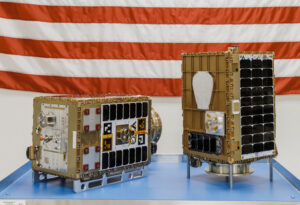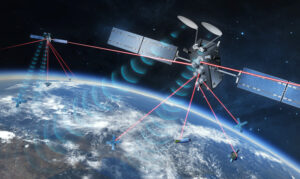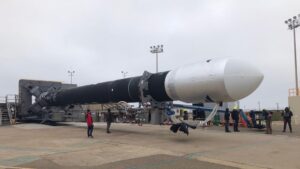Intelsat announces successful emergence from financial restructuring process
Friday, 25 February 2022 05:59 Intelsat S.A. has successfully completed and emerged from its financial restructuring process as a private company with a substantially strengthened capital structure to support its growth as the leader in satellite communications. This final milestone follows receipt of regulatory approvals, completion of certain corporate actions, and satisfaction of other customary conditions.
Intelsat'
Intelsat S.A. has successfully completed and emerged from its financial restructuring process as a private company with a substantially strengthened capital structure to support its growth as the leader in satellite communications. This final milestone follows receipt of regulatory approvals, completion of certain corporate actions, and satisfaction of other customary conditions.
Intelsat' PPM partners with Aston Uni to develop game-changing satcom technology
Friday, 25 February 2022 05:59 Pulse Power and Measurement Ltd (PPM) has been working with Aston University through a Knowledge Transfer Partnership (KTP) to develop a game-changing approach to technology used in the radio-over-fibre communications industry. The project will look to transform the connection between low earth orbit (LEO) satellite antenna dishes and modems through optics rather than electronics, delivering per
Pulse Power and Measurement Ltd (PPM) has been working with Aston University through a Knowledge Transfer Partnership (KTP) to develop a game-changing approach to technology used in the radio-over-fibre communications industry. The project will look to transform the connection between low earth orbit (LEO) satellite antenna dishes and modems through optics rather than electronics, delivering per Dusty Flight 19 completed and looking ahead to Flight 20
Friday, 25 February 2022 05:59 Flight 19 was successfully completed on February 7, 2022, at 20:21 PST (Sol 345 of the Perseverance mission, 12:00 LMST Local Mean Solar Time), and placed Ingenuity safely within the designated landing ellipse just above the eastern ridge of the "South Seitah" basin. Flight 19 was a reminder of the challenges and unpredictability of the Martian environment.
As discussed in our previous upd
Flight 19 was successfully completed on February 7, 2022, at 20:21 PST (Sol 345 of the Perseverance mission, 12:00 LMST Local Mean Solar Time), and placed Ingenuity safely within the designated landing ellipse just above the eastern ridge of the "South Seitah" basin. Flight 19 was a reminder of the challenges and unpredictability of the Martian environment.
As discussed in our previous upd NASA plans mid-March test for SLS moon rocket's first flight
Friday, 25 February 2022 05:59 NASA officials said Thursday the space agency is making progress toward a crucial test in mid-March of the first moon rocket since the Apollo-era but the agency did not set a new launch date for the first lunar mission.
NASA plans the full "wet-dress rehearsal" of the SLS moon rocket on the pad at 6 p.m. ET on March 17.
The first such mission to the moon, although uncrewed, may h
NASA officials said Thursday the space agency is making progress toward a crucial test in mid-March of the first moon rocket since the Apollo-era but the agency did not set a new launch date for the first lunar mission.
NASA plans the full "wet-dress rehearsal" of the SLS moon rocket on the pad at 6 p.m. ET on March 17.
The first such mission to the moon, although uncrewed, may h HSE University researchers discover what happens on the bright side of the moon
Friday, 25 February 2022 05:59 Researchers from HSE University have developed a mathematical model that explains the levitation of charged dust particles over the sunlit lunar surface for almost any latitude. For the first time, the model takes into account the Earth's magnetotail-a particular area around our planet. The research data is important for planning the Luna-25 and Luna-27 space missions. The study was published in
Researchers from HSE University have developed a mathematical model that explains the levitation of charged dust particles over the sunlit lunar surface for almost any latitude. For the first time, the model takes into account the Earth's magnetotail-a particular area around our planet. The research data is important for planning the Luna-25 and Luna-27 space missions. The study was published in Organic compounds on Ceres
Friday, 25 February 2022 05:59 The third-largest crater on the dwarf planet Ceres was geologically active at least once many millions of years after its formation. In a recent study published in the journal Nature Communications, researchers from the Max Planck Institute for Solar System Research (MPS) in Gottingen, the University of Munster (WWU) and the National Institute of Science Education and Research (NISER) in Bhubane
The third-largest crater on the dwarf planet Ceres was geologically active at least once many millions of years after its formation. In a recent study published in the journal Nature Communications, researchers from the Max Planck Institute for Solar System Research (MPS) in Gottingen, the University of Munster (WWU) and the National Institute of Science Education and Research (NISER) in Bhubane Sols 3396-3397: Sediment Before the Pediment
Friday, 25 February 2022 05:59 If all goes according to plan, the rover's drive on sol 3397 will position us at the edge of the rocks that cap Greenheugh Pediment. This drive was pushed back from sol 3395 in order to collect even more data on the sedimentary rocks in our current workspace before we leave this rock formation and enter into a new one. This transition is documented in the Mastcam drive direction image above, in
If all goes according to plan, the rover's drive on sol 3397 will position us at the edge of the rocks that cap Greenheugh Pediment. This drive was pushed back from sol 3395 in order to collect even more data on the sedimentary rocks in our current workspace before we leave this rock formation and enter into a new one. This transition is documented in the Mastcam drive direction image above, in Ch'al-Type Rocks at Santa Cruz
Friday, 25 February 2022 05:59 NASA's Perseverance Mars rover snapped this view of a hill in Mars' Jezero Crater called "Santa Cruz" on April 29, 2021, the 68th Martian day, or sol, of the mission. About 20 inches (50 centimeters) across on average, the boulders in the foreground are among the type of rocks the rover team has named "Ch'al" (the Navajo term for "frog" and pronounced "chesh"). Perseverance will return to the ar
NASA's Perseverance Mars rover snapped this view of a hill in Mars' Jezero Crater called "Santa Cruz" on April 29, 2021, the 68th Martian day, or sol, of the mission. About 20 inches (50 centimeters) across on average, the boulders in the foreground are among the type of rocks the rover team has named "Ch'al" (the Navajo term for "frog" and pronounced "chesh"). Perseverance will return to the ar Roman Space Telescope could snap first image of a Jupiter-like world
Friday, 25 February 2022 05:59 NASA's Nancy Grace Roman Space Telescope, now under construction, will test new technologies for space-based planet hunting. The mission aims to photograph worlds and dusty disks around nearby stars with detail up to a thousand times better than possible with other observatories.
Roman will use its Coronagraph Instrument - a system of masks, prisms, detectors, and even self-flexing mirrors
NASA's Nancy Grace Roman Space Telescope, now under construction, will test new technologies for space-based planet hunting. The mission aims to photograph worlds and dusty disks around nearby stars with detail up to a thousand times better than possible with other observatories.
Roman will use its Coronagraph Instrument - a system of masks, prisms, detectors, and even self-flexing mirrors Astronomers map mysterious element in space
Friday, 25 February 2022 05:59 A research team led by Lund University in Sweden has provided an important clue to the origin of the element Ytterbium in the Milky Way, by showing that the element largely originates from supernova explosions. The groundbreaking research also provides new opportunities for studying the evolution of our galaxy. The study is published in Astronomy and Astrophysics.
Ytterbium is one of four
A research team led by Lund University in Sweden has provided an important clue to the origin of the element Ytterbium in the Milky Way, by showing that the element largely originates from supernova explosions. The groundbreaking research also provides new opportunities for studying the evolution of our galaxy. The study is published in Astronomy and Astrophysics.
Ytterbium is one of four Successful first year for UK-Australia Space Bridge
Friday, 25 February 2022 05:59 This week marks the first anniversary of the Space Bridge between UK and Australia - a partnership focused on facilitating collaboration between the two countries' space sectors. A world first, the Space Bridge has unlocked improved access to trade, investment and academic research opportunities, better advice to businesses and innovative bilateral collaborations.
The arrangement enhances
This week marks the first anniversary of the Space Bridge between UK and Australia - a partnership focused on facilitating collaboration between the two countries' space sectors. A world first, the Space Bridge has unlocked improved access to trade, investment and academic research opportunities, better advice to businesses and innovative bilateral collaborations.
The arrangement enhances Orbital Sidekick notes growing demand for hyperspectral data
Friday, 25 February 2022 00:46
Capacity is the biggest constraint for Orbital Sidekick, the hyperspectral imaging startup that is acquiring data from Aurora, its first sensor launched in June.
The post Orbital Sidekick notes growing demand for hyperspectral data appeared first on SpaceNews.
SpaceLink adds smaller satellites to data-relay constellation
Thursday, 24 February 2022 22:57
SpaceLink announced plans Feb. 24 to establish an initial constellation of smaller satellites than previously planned, a move designed to slash the cost and speed up the rollout of initial data-relay services.
The post SpaceLink adds smaller satellites to data-relay constellation appeared first on SpaceNews.
U.S. Space Command needs help identifying hostile intent in space
Thursday, 24 February 2022 22:39
If Russia or any other actor were to intentionally interfere with U.S. satellites, it would be difficult to identify the aggressor, said the top commander of U.S. military space operations.
The post U.S.
AE Industrial Partners to acquire stake in Firefly from Noosphere
Thursday, 24 February 2022 20:53
AE Industrial Partners is buying the part of Firefly Aerospace currently owned by Noosphere Venture Partners, which previously announced it was being forced by the federal government to sell its stake in the launch vehicle developer.

